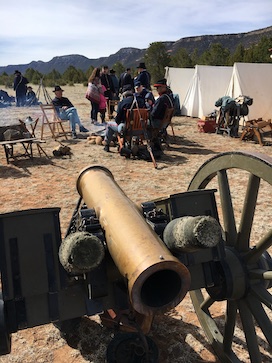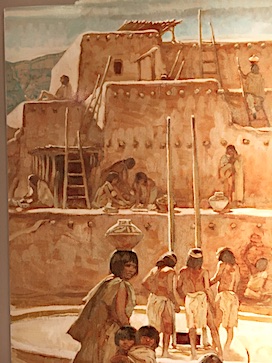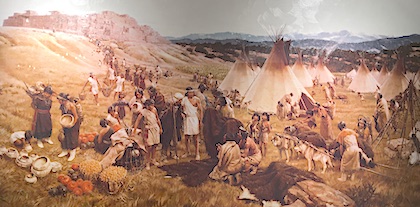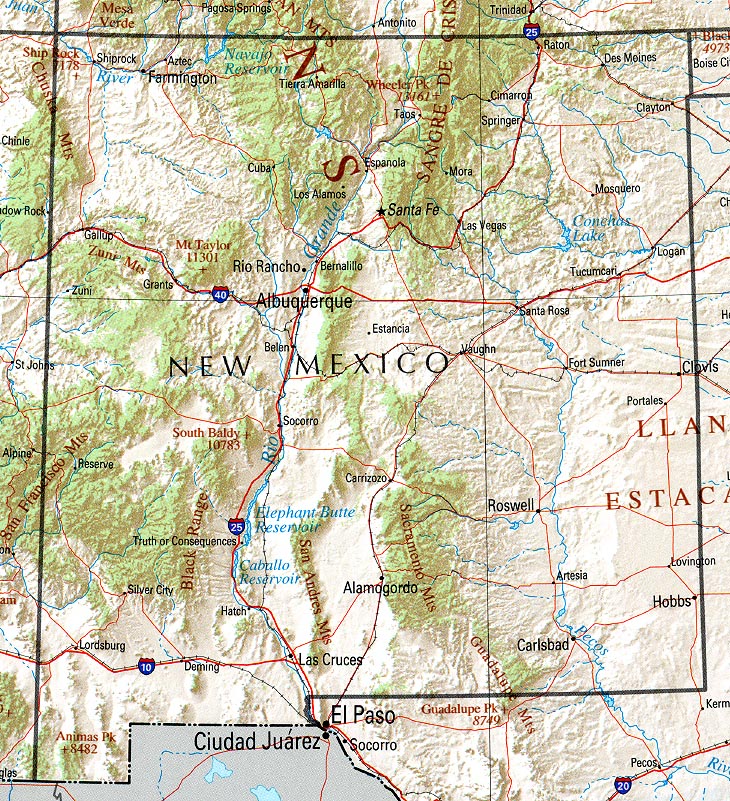The little Hispanic village of Pecos is located just off I-25 North about twenty-five miles after leaving Santa Fe at the junction of NMHwy-50 and 63. Locations nearby include Pecos National Historical Park, Glorieta Pass, Pecos Benedictine Monastery, and Lisboa Springs Trout Hatchery. It is also an entry point for hunting, fishing, hiking and camping in the Pecos Wilderness. After going through town NMHwy-63 is the major road following the Pecos River going up into the Pecos Mountains, the eastern subrange of the Sangre de Cristo Mountains where it dead ends at a campground/horse corrals above the little community of Cowles.
What is now the Pecos National Historical Park is well-known for several historical events. It was the home to the Pecos Indians who were a regional power situated in the valley connecting the people of the plains with the Rio Grande valley. The village was built by puebloans from several smaller villages around the end of the 1300's or beginning of the 1400's. Their 4-5 story buildings were built on the top of a steep-sided mesa that provided protection from other tribes. It was occupied by them until 1838 when the last 20 or so residents left and walked to the Jemez Pueblo where their fellow Towa speaker lived. There are still residents at Jemez with the last name of Pecos! Every year on August 2nd. community members from the Pueblo of Jemez and Pecos celebrate Feast Day mass inside the ruin church of Our Lady of the Angels of Porciúncula (Nuestra Señora de los Ángeles de Porciúncula) at the Pecos Pueblo. The Spanish built the church (the third one) after colonizing New Mexico. An excellent resource about the Pecos Indians and the Spanish is the "Kiva, Cross and Crown" written by John Kessell.
Since the valley in which the pueblo was built is the southern most wide valley between the Great American Plains and the Rio Grande River, it has been an
important thoroughfare for travelers who want to pass through the Sangre de Cristo mountains. There is evidence of its use by the early hunter/gather people as well as many other tribes later in history. It was on the major route of the Santa Fe Trail as well as the Santa Fe Railroad linking the east with the western parts of the United States.
A major civil war battle was fought between March 26-28, 1862 not far from there in Glorieta Pass. The Confederate troops (Texans) of General Henry Hopkins Sibley and the Union troops (mainly Colorado miners) of General Edward Canby fought the Battle of Glorieta Pass. Winning this battle by the Union troops defeated the idea of the Confederacy gaining control of the Colorado and California gold fields and the deep water ports of California.
My wife Susan and I conducted an extensive study of the plants blooming on the Pueblo Ruins and Mission Trail in 2017. We were also Volunteers in the Park (VIPs) working in the Visitor Center for two years after that.
Gallery
Views around the Pueblo
 |
 |
|---|---|
| Pecos Feast Day Celebration, 2019 | Civil War Reinactors, March 23, 2019 |
 |
|---|
| Representation of life in the Pueblo |
 |
|---|
| Representation of trading days at the Pueblo with the plains tribes |
